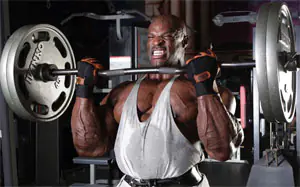Consider another famous Vader principlecalled "maximum voltage" or "peak muscle contraction". This technique is a technique by which you maintain the highest level of tension in the involved muscles while they are in a state of full contraction. For example, when you do arm curls with dumbbells while standing, then, as a rule, in the upper part of the movement path you lose the feeling of resistance, “turning off” your arms with the apparatus... To compensate for this loss and achieve the effect of resistance on the maximally contracted muscle, in the final stage exercises lean forward. With this technique, your hands will never “turn off” and will always be at work.
Now let's look at this in more detail and in more detail:
The “maximum voltage” principle is essential for high-quality drawing muscle relief and, in particular, the upper outline of the muscle (for example, the so-called “high” biceps). Remember a simple rule: The more degree of reduction target muscle, so more will be hers height And convex, the more perfect and ideal it will be form.
So, the task came down to maximally contracting the muscle in the exercises, which is the main target...
But, in practice, by performing some movements, achieve maximum contraction of the involved muscle sometimes it's not possible, due to the fact that some parts of our body interfere with the movement of the barbell at a stage preceding the position of full contraction of the target muscle. For example, if an athlete with a convex, massive chest performs a bent-over row of a barbell in front of him, the bar of the apparatus will stop before the back muscle contracts to its maximum. A similar situation can be observed when working out the biceps - “bend curls with a barbell while standing.” In this exercise, the highest muscle contraction also does not occur due to two reasons:
- the first one is identical to the example with the back, which we already talked about earlier,
- the second is related to the force of gravity, which in this situation facilitates the final part of the exercise, since when the bar is at the highest point of the amplitude of movement, it is gravity, and not our biceps muscle, that pulls it to the chin.
The effectiveness indicators of this version of the exercise are visible in the second diagram. For comparison, the first diagram shows the effectiveness of the same exercise when performed in the classical way. From the above pictures it can be seen that at a right angle, between the arm and torso, the effectiveness of the effect is 100%. But as the angle gradually increases, it drops significantly. For example, at 157° the efficiency is only 38%. Well, in the most extreme position of the hands, at a time when the contraction should have reached its highest degree, the effectiveness is practically zero. The second diagram clearly shows the effectiveness of the exercise using special adapter handles. With this option, it increases by 100%, despite the fact that at angles of 40-90° it is significantly lower. But, starting from a right angle and up to 157°, it is at least 90%. This means that at peak contraction we achieved almost the highest performance efficiency, which is so necessary for us to acquire relief, and a “high” rise of the muscle, in the absence of which our figure cannot be fully considered perfect and harmonious.
Post Views: 141


